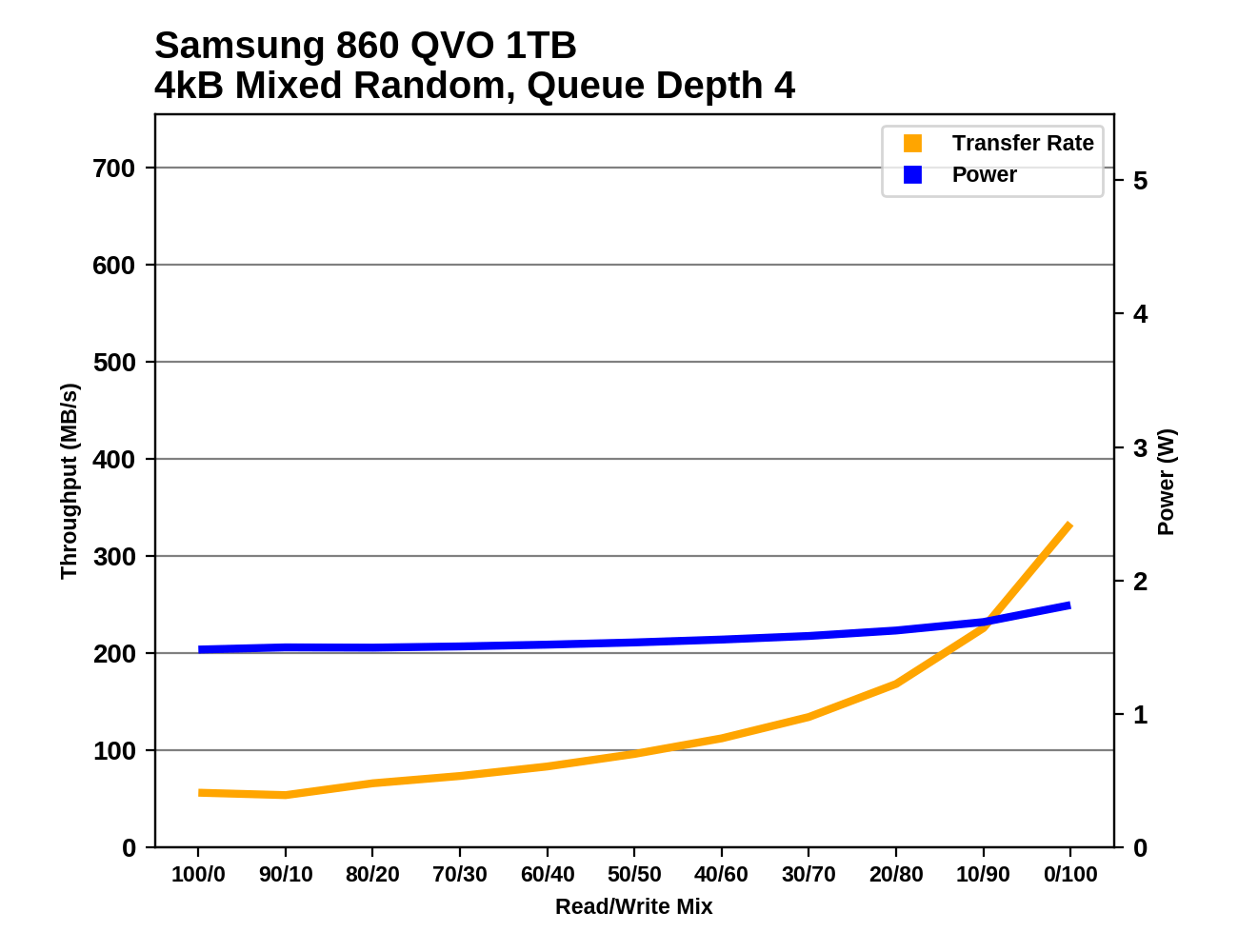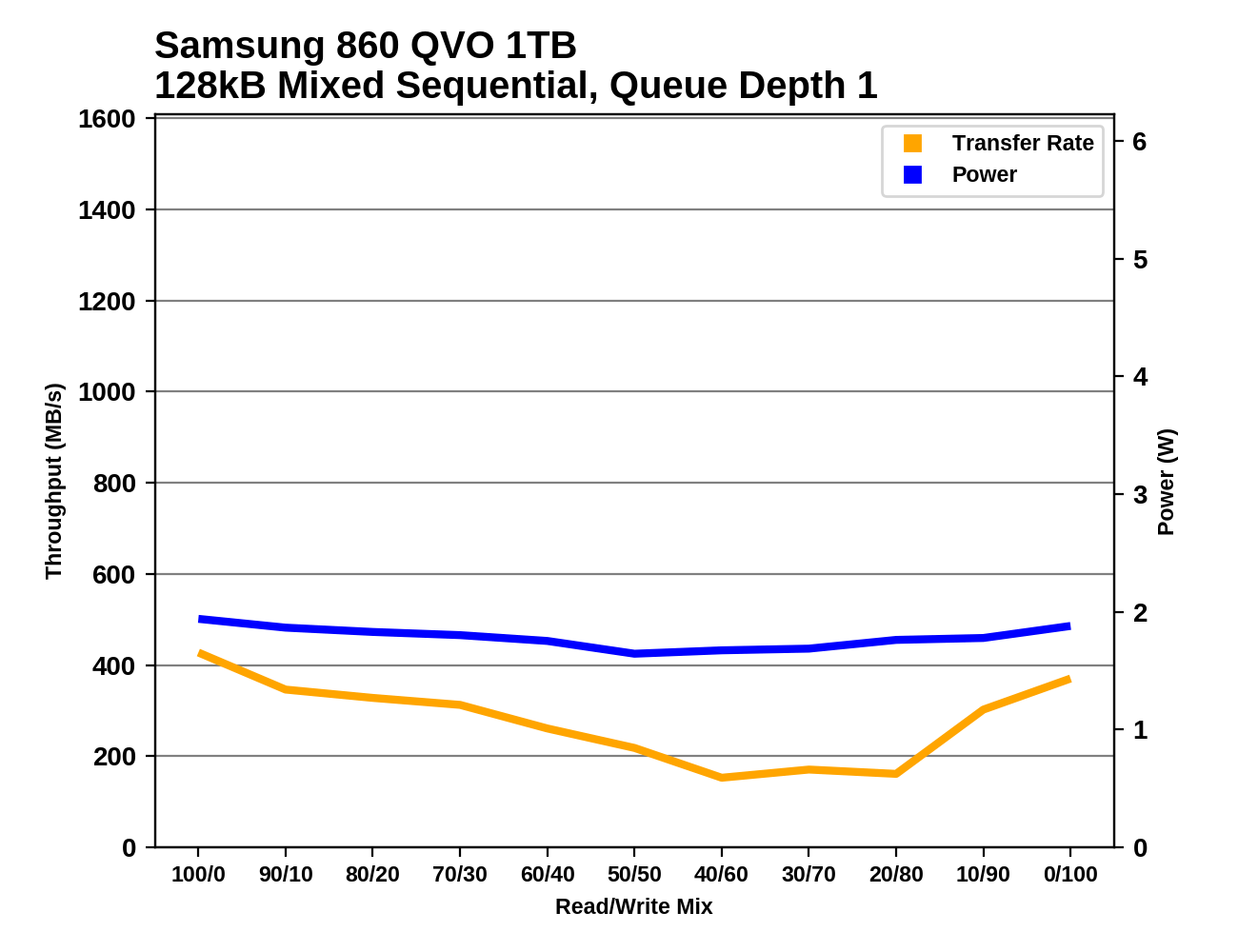The Samsung 860 QVO (1TB, 4TB) SSD Review: First Consumer SATA QLC
by Billy Tallis on November 27, 2018 11:20 AM ESTMixed Random Performance
Our test of mixed random reads and writes covers mixes varying from pure reads to pure writes at 10% increments. Each mix is tested for up to 1 minute or 32GB of data transferred. The test is conducted with a queue depth of 4, and is limited to a 64GB span of the drive. In between each mix, the drive is given idle time of up to one minute so that the overall duty cycle is 50%.

The Samsung 860 QVO's performance on the mixed random I/O test is substantially slower than the 860 EVO, but it is not far behind some of the other mainstream TLC drives. Running the test on a full drive does slow the 1TB 860 QVO down significantly, but it remains faster than the DRAMless TLC drive.
 |
|||||||||
| Power Efficiency in MB/s/W | Average Power in W | ||||||||
The power efficiency rankings for the 860 QVO aren't much better than the raw performance rankings. Power consumption is generally a bit higher than the 860 EVO but doesn't vary much with capacity or state of fill, so the efficiency scores are largely reflective of the performance variations.
 |
|||||||||
The 860 QVO starts out with a fairly slow random read speed but steadily speeds up as the workload shifts toward writes, eventually catching up to the 860 EVO. When the test is run on a full drive, the 1TB 860 QVO runs out of SLC cache in the final few phases of the test and slows down instead of continuing to speed up.
Mixed Sequential Performance
Our test of mixed sequential reads and writes differs from the mixed random I/O test by performing 128kB sequential accesses rather than 4kB accesses at random locations, and the sequential test is conducted at queue depth 1. The range of mixes tested is the same, and the timing and limits on data transfers are also the same as above.

The 4TB 860 QVO handles the mixed sequential I/O test well, but the 1TB model ends up slightly slower than the DRAMless TLC drive and well behind the mainstream TLC drives.
 |
|||||||||
| Power Efficiency in MB/s/W | Average Power in W | ||||||||
The power efficiency scores vary more among the SATA drives than the raw performance scores, so the 860 EVO and Toshiba TR200 stand out as particularly efficient while the 860 QVO 4TB is merely average and the 1TB model is struggling a bit.
 |
|||||||||
Both capacities of the 860 QVO offer decent performance at either end of the test with pure reads or pure writes, and they are unsurprisingly at their worst with the more write-heavy mixes. The 1TB 860 QVO loses far more performance across the first two thirds of the test, but catches back up with the 4TB model at the end.










109 Comments
View All Comments
Impulses - Thursday, November 29, 2018 - link
Bleh, googling revealed that WAS on Amazon... It never triggered my price alerts, hrm, even tho it's definitely showing on Camelcamel's price history now, weird. Maybe I glossed over it entirely, oh well.The_Assimilator - Thursday, November 29, 2018 - link
https://www.pcgamer.com/crucials-2tb-mx500-ssd-is-...hojnikb - Tuesday, November 27, 2018 - link
@BillyCan you do a data retention test ? Like writing the drive with data (H2testw seems to be the pick of the bunch) and disconnecting it. I'm interested how data retention holds up over time.
JoeyJoJo123 - Tuesday, November 27, 2018 - link
Don't use SSDs for cold storage. Testing this is absurdly stupid and a waste of a reviewers time.Disconnect drive for 10 days: Replug it in and verify data's still all there. Yep.
Disconnect drive for 15 days: Replug it in and verify data's still all there. Yep.
Disconnect drive for 20 days: Replug it in and verify data's still all there. Yep.
(We're already at 45 days, or 1.5 months, and chances are the data's still all there, are you getting how and why this kind of testing is stupid?)
By the time you get to sufficiently long enough time periods to see some change in data you'd have wasted over a year trying to find a time period (within 5 days) where you know the drive will start losing data. This is just as absurd as asking reviewers to test NAND flash endurance by hammering the drive 24/7 for years until it dies. By the time it DOES die something better will have already arrived on the market. And disregarding all that, testing with a sample size of ONE is not indicative of any relevant performance characteristics for your ONE drive.
If you want to use cold storage backups, either use a mechanical hard drive, a tape drive, or invest in cloud storage and encrypt your data before uploading it.
Testing the cold storage capabilities of a sample size of ONE QLC SSD does nothing but prove that it's a less satisfactory use case for the technology than using a mechanical hard drive.
HollyDOL - Tuesday, November 27, 2018 - link
I _think_ you can find Google or Facebook statistics on their SSDs, error rate etc. in representative volumes. But ofc it is enterprise grade hardware.hojnikb - Wednesday, November 28, 2018 - link
Not for QLC.hojnikb - Wednesday, November 28, 2018 - link
You're not thinking very far. As QLC is very cheap, it will be used in likes of flash drives, SD cards and portable SSDs. With these, it's not expected for them to be powerred at all time and in the case of sd cards and flash drives, it's not likely controller would do any kind of data rewritting.So this is very much a relavant test, that might give us ideas on how it performs. And no, you don't have to wait a year to see something; data curruption can be presented a lot sooner if from of read error and slower read speed in general. A more extreme approach is to heat the drive, which accelarates the process.
eddieobscurant - Tuesday, November 27, 2018 - link
Horrible performance by samsung 64 layer qlc nand. Way slower than intel's/micron's . Especially the 4k random reads are slower than my first ssd 10 years ago, the intel x-25m.In order for samsung 860 qvo to make sense, it should be priced below 0.10$/gb
stargazera5 - Tuesday, November 27, 2018 - link
Great, now that we have QLC down, we can move on to PLC (5 bits per cell) and 1 drive write per week.CheapSushi - Wednesday, November 28, 2018 - link
And from the current trend, it still won't be much cheaper. =P